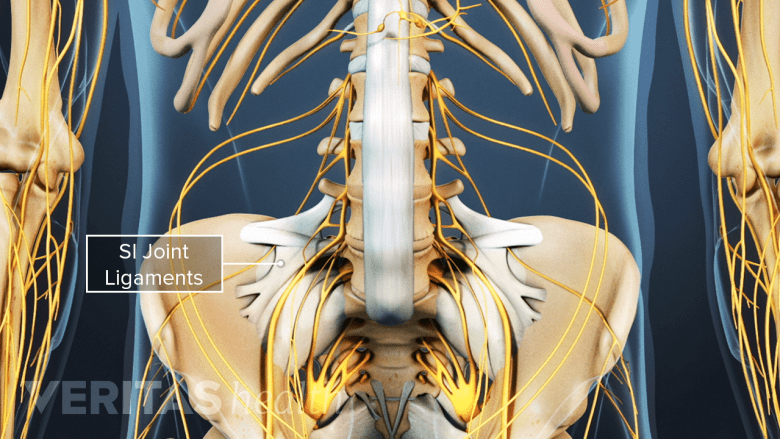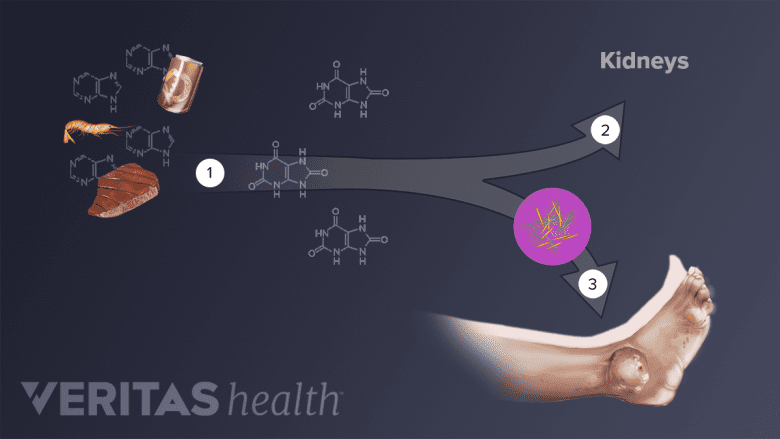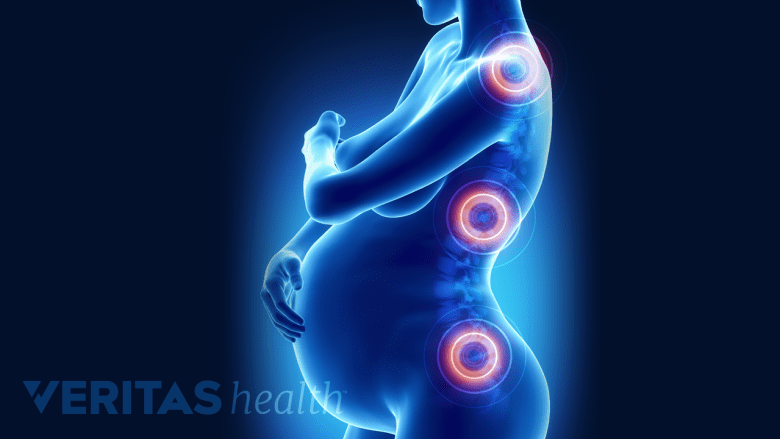Ankylosing spondylitis, a type of inflammatory arthritis, is the most common cause of sacroiliitis.1Baronio M, Sadia H, Paolacci S, et al. Etiopathogenesis of sacroiliitis: implication for assessment and management. Korean J Pain. 2022;33(4):294-304. http://doi.org/10.3344/kjp.2020.33.4.294 Research indicates that 5% to 6% of the worldwide population is affected by ankylosing spondylitis, and inflammation and pain in the SI joint are typically the first manifestations of this potentially debilitating condition.2Wenker KJ, Quint JM. Ankylosing Spondylitis. [Updated 2022 Apr 9]. In: StatPearls [Internet]. Treasure Island (FL): StatPearls Publishing; 2023 Jan-. Available from: https://www.ncbi.nlm.nih.gov/books/NBK470173/
Additionally, traumatic injuries and mechanical stresses may also cause inflammation of the SI joint.
Watch Video: What is Sacroiliitis?
Inflammatory Causes of Sacroiliitis

Arthritis is a common cause of sacroiliitis.
Inflammatory causes of sacroiliitis comprise rheumatic, infectious, and other inflammatory conditions that affect the joint.
Arthritis
Ankylosing spondylitis is a type of arthritis that primarily affects the spine, causing inflammation and stiffness.2Wenker KJ, Quint JM. Ankylosing Spondylitis. [Updated 2022 Apr 9]. In: StatPearls [Internet]. Treasure Island (FL): StatPearls Publishing; 2023 Jan-. Available from: https://www.ncbi.nlm.nih.gov/books/NBK470173/ Over time, the inflammation can lead to SI joint erosion and fusion, which can cause permanent damage and further restrict mobility.
Other common forms of arthritis that affect the SI joint include osteoarthritis, psoriatic, and reactive arthritis.
Autoimmune disorders
Sacroiliitis is usually the first manifestation of autoimmune disorders, such as ankylosing spondylitis, psoriasis, and arthritis.1Baronio M, Sadia H, Paolacci S, et al. Etiopathogenesis of sacroiliitis: implication for assessment and management. Korean J Pain. 2022;33(4):294-304. http://doi.org/10.3344/kjp.2020.33.4.294
Inflammatory bowel diseases
Common inflammatory bowel diseases like Crohn’s disease and ulcerative colitis can cause sacroiliitis
Infection
Bacterial, viral, or fungal infections can affect the SI joint and trigger an inflammatory response.1Baronio M, Sadia H, Paolacci S, et al. Etiopathogenesis of sacroiliitis: implication for assessment and management. Korean J Pain. 2022;33(4):294-304. http://doi.org/10.3344/kjp.2020.33.4.294 Pyogenic sacroiliitis, caused by bacterial infection, is rare but can cause acute inflammation of the joint.3Buchanan BK, Varacallo M. Sacroiliitis. [Updated 2022 Sep 4]. In: StatPearls [Internet]. Treasure Island (FL): StatPearls Publishing; 2022 Jan-. Available from: https://www.ncbi.nlm.nih.gov/books/NBK448141/
In This Article:
Mechanical Causes of Sacroiliitis

Repetitive physical stress can cause SI joint inflammation.
Mechanical causes of sacroiliitis are related to the physical stress placed on the SI joint. Mechanical stress can result from microtrauma that occurs within the joint over a period of time or physical changes in the body that increase stress on the joint.1Baronio M, Sadia H, Paolacci S, et al. Etiopathogenesis of sacroiliitis: implication for assessment and management. Korean J Pain. 2022;33(4):294-304. http://doi.org/10.3344/kjp.2020.33.4.294
Mechanical stress and chronic micro-trauma
Occupational, recreational, or sport-related activities that require repetitive or prolonged standing, sitting, or bending can cause increased mechanical stress to the SI joint. Over time, micro-trauma from these stresses may cause inflammation of the joint.
Overuse injuries
Overuse injuries occur when the SI joint is subjected to repetitive stress over a period of time. Such injuries are frequently seen in athletes who train excessively or in individuals who perform heavy lifting or manual labor.
Poor posture
Unsupported posture and poor work ergonomics can increase the stress on the lower back and SI joints, which can lead to inflammation and pain in the joint over time.
Pregnancy
Hormonal changes during pregnancy cause the ligaments surrounding the SI joint to relax, which may lead to joint instability and inflammation.
Traumatic Causes of Sacroiliitis

Ligaments surrounding the SI joint can be stretched or torn during trauma.
Traumatic causes of sacroiliitis are related to a specific injury or trauma to the SI joint.
Falls
Falls can cause significant trauma to the SI joint, resulting in inflammation and pain. Traumatic falls are more frequent in the elderly population.4Lee A, Gupta M, Boyinepally K, Stokey PJ, Ebraheim NA. Sacroiliitis: A Review on Anatomy, Diagnosis and Treatment. Advances in Orthopedics. 2022. http://doi.org/10.1155/2022/3283296
Motor vehicle accidents
The sudden impact from a motor vehicle accident can cause the bones in the pelvis to mildly shift or become misaligned, resulting in inflammation and pain in the SI joint.3Buchanan BK, Varacallo M. Sacroiliitis. [Updated 2022 Sep 4]. In: StatPearls [Internet]. Treasure Island (FL): StatPearls Publishing; 2022 Jan-. Available from: https://www.ncbi.nlm.nih.gov/books/NBK448141/
Sport injuries
Sport injuries can cause the ligaments and soft tissues in the pelvis to become overstretched or torn, causing SI joint pain. Sport-related injuries are most common in young adults.1Baronio M, Sadia H, Paolacci S, et al. Etiopathogenesis of sacroiliitis: implication for assessment and management. Korean J Pain. 2022;33(4):294-304. http://doi.org/10.3344/kjp.2020.33.4.294,3Buchanan BK, Varacallo M. Sacroiliitis. [Updated 2022 Sep 4]. In: StatPearls [Internet]. Treasure Island (FL): StatPearls Publishing; 2022 Jan-. Available from: https://www.ncbi.nlm.nih.gov/books/NBK448141/
Less Common Causes of Sacroiliitis
The less common causes of sacroiliitis are discussed below.

Gout typically affects the joints in the feet, but can also affect the SI joint.
Gouty arthritis
Gout is a type of inflammatory arthritis involving the build-up of uric acid crystals in specific joints. Gouty arthritis of the SI joints can trigger an inflammatory response, causing pain, swelling, and stiffness in the joint.
The condition can be excruciating and debilitating, limiting the patient's mobility. Gouty arthritis is typically more common in middle-aged men and post-menopausal women.5Namas R, Hegazin SB, Memişoğlu E, Joshi A. Lower back pain as a manifestation of acute gouty sacroiliitis: Utilization of dual-energy computed tomography (DECT) in establishing a diagnosis. Eur J Rheumatol. 2019;6(4):216-218. http://doi.org/10.5152/eurjrheum.2019.18097
Read more about Gout on Arthritis-health.com
Enthesopathy
Enthesopathy is a disorder of the connective tissue (enthesis) that connects tendons or ligaments to bones. Increased mechanical stress on the SI joint may sometimes cause this connective tissue to become inflamed or degenerate, reducing the joint’s stability and causing sacroiliitis.
In some cases, inflammation of the connective tissues can trigger an immune response that mistakenly attacks the SI joint, leading to sacroiliitis.1Baronio M, Sadia H, Paolacci S, et al. Etiopathogenesis of sacroiliitis: implication for assessment and management. Korean J Pain. 2022;33(4):294-304. http://doi.org/10.3344/kjp.2020.33.4.294

Scoliosis is a rare, but possible cause of sacroiliitis.
Scoliosis
Scoliosis is a medical condition that causes the spine to abnormally curve sideways. Scoliosis may lead to uneven weight distribution in the pelvis, leading to increased mechanical stress on the SI joint.6Šarčević Z, Tepavčević A. Association between adolescent idiopathic scoliosis and sacroiliac joint dysfunction in young athletes: A case control study. Medicine (Baltimore). 2019; 98(15):e15161. http://doi.org/10.1097/MD.0000000000015161,7Fenton DS. Chapter 63 – Sacroiliitis. In: Czervionke LF, Fenton DS, eds. Imaging painful spine disorders. 1st ed. Saunders; 2011:476-481. https://doi.org/10.1016/B978-1-4160-2904-5.00063-X
Brucellosis
Brucella is a type of bacteria mainly transmitted through contact with infected animals or their products (such as unpasteurized dairy products). These bacteria can cause an infection and trigger an inflammatory response called brucellosis.8Gheita TA, Sayed S, Azkalany GS, Fishawy HS, Aboul-Ezz MA, Shaaban MH, Bassyouni RH. Subclinical sacroiliitis in brucellosis. Clinical presentation and MRI findings. Zeitschrift fur Rheumatologie. 2015;74(3):240-245. http://doi.org/10.1007/s00393-014-1465-1
Brucellosis typically affects the lower spine and may include the SI joint. Typical symptoms include lower back pain, buttock pain, pain along the side of the abdomen (flank area), fever, and a general feeling of malaise.9European Society of Radiology. Unilateral sacroilitis due to brucellosis: MRI findings. CASE 14468. Published on 18.04.2017. Accessed March 7, 2023. https://www.eurorad.org/case/14468,10Gupta A, Shyam A, Sancheti P, Aiyer S. Brucellosis sacroiliitis masquerading as inflammatory spondyloarthropathy. Indian Spine J. 2022;5(2):241. http://doi.org/10.4103/isj.isj_38_21
Retinoid medication
Retinoids are used for the treatment of severe acne and help promote faster turnover of surface skin cells and boost collagen. Research suggests that the use of retinoids may cause musculoskeletal inflammation in rare cases, including sacroiliitis.11Rozin AP, Kagna O, Shiller Y. Sacroiliitis and severe disability due to isotretinoin therapy. Rheumatol Int. 2010;30(7):985-986. http://doi.org/10.1007/s00296-009-1014-4,12Yilmaz Tasdelen O, Yurdakul FG, Duran S, Bodur H. Isotretinoin-induced arthritis mimicking both rheumatoid arthritis and axial spondyloarthritis. Int J Rheum Dis. 2014. http://doi.org/10.111/1756-185X,12464
Any concerning symptoms in the lower back, buttock, hip, abdomen, pelvis, or thigh must be discussed with a doctor for an accurate diagnosis and prompt treatment.
Risk Factors for Sacroiliitis

Women are more susceptible to SI joint problems.
Certain risk factors may increase the likelihood of developing sacroiliitis.
The most common risk factors for sacroiliitis include:
- Genetics. Specific genes have been identified that increase the risk of developing sacroiliitis. The HLA-B27 gene is strongly associated with ankylosing spondylitis and other types of inflammatory arthritis.13Brown CR, Reiner SL. Genes outside the major histocompatibility complex control resistance and susceptibility to experimental Lyme arthritis. Medical Microbiol Immunol. 2002;189:85-90. http://doi.org/10.1007/s004300000044 Research indicates that if a parent has a history of inflammatory arthritis, their child is 52 times more likely to develop sacroiliitis.1Baronio M, Sadia H, Paolacci S, et al. Etiopathogenesis of sacroiliitis: implication for assessment and management. Korean J Pain. 2022;33(4):294-304. http://doi.org/10.3344/kjp.2020.33.4.294
- Gender. Women have more flexibility in their SI joints and are more susceptible to SI joint dysfunction due to the increased stress, movement, and load on the surrounding structures.
- Age. Young-to-middle-aged individuals between the ages of 20 years to 50 years may be at a higher risk of sacroiliitis due to trauma from physical activities like sport injuries and heavy lifting. As the body ages, the cartilage in the joints begins to wear down, which can lead to inflammation and pain in the sacroiliac joints for older adults.3Buchanan BK, Varacallo M. Sacroiliitis. [Updated 2022 Sep 4]. In: StatPearls [Internet]. Treasure Island (FL): StatPearls Publishing; 2022 Jan-. Available from: https://www.ncbi.nlm.nih.gov/books/NBK448141/
- Intravenous drug use. Injecting drugs into the body can damage the veins and surrounding tissues, leading to inflammation and other infections, which can spread to nearby structures, including the SI joint.1Baronio M, Sadia H, Paolacci S, et al. Etiopathogenesis of sacroiliitis: implication for assessment and management. Korean J Pain. 2022;33(4):294-304. http://doi.org/10.3344/kjp.2020.33.4.294
- Lumbar spine surgery. Lumbar spine surgery is a risk factor for SI joint pain due to weakening of the surrounding ligaments and/or damage to the joint mechanics due to grafts taken from the iliac (hip) bone.2Wenker KJ, Quint JM. Ankylosing Spondylitis. [Updated 2022 Apr 9]. In: StatPearls [Internet]. Treasure Island (FL): StatPearls Publishing; 2023 Jan-. Available from: https://www.ncbi.nlm.nih.gov/books/NBK470173/
- Weakened immune system. Individuals with weakened immune systems, such HIV/AIDS or other autoimmune diseases, may be more susceptible to infections that can potentially lead to sacroiliitis.3Buchanan BK, Varacallo M. Sacroiliitis. [Updated 2022 Sep 4]. In: StatPearls [Internet]. Treasure Island (FL): StatPearls Publishing; 2022 Jan-. Available from: https://www.ncbi.nlm.nih.gov/books/NBK448141/
- Differences in leg length. Individuals with leg length discrepancies are more likely to develop SI joint pain, which can lead to chronic inflammation.14Kiapour A, Abdelgawad AA, Goel VK, Souccar T, Terai T, Ebraheim NA. Relationship between limb length didiscrepancynd load distribution across the sacroiliac oint—a finite study. Journal of Orthopaedic Research.. 2012;30(10):1577-1580. http://doi.org/10.1002/jor.22119
The presence of one or more of these risk factors does not guarantee that a person will develop sacroiliitis, but when combined with the individual's age and general health, there may be a higher likelihood of developing the condition.
Sacroiliitis from Cancer or Cancer Treatment
Cancer from various parts of the body may spread near the SI joint region (malignant cancer), weakening the joint and leading to inflammation. Additionally, cancer treatments may worsen any pre-existing arthritis in the joint, leading to the worsening of the inflammation within the joint.15Kiapour A, Abdelgawad AA, Goel VK, Souccar T, Terai T, Ebraheim NA. Relationship between limb length didiscrepancynd load distribution across the sacroiliac oint—a finite study. Journal of Orthopaedic Research.. 2012;30(10):1577-1580. http://doi.org/10.1002/jor.22119
- 1 Baronio M, Sadia H, Paolacci S, et al. Etiopathogenesis of sacroiliitis: implication for assessment and management. Korean J Pain. 2022;33(4):294-304. http://doi.org/10.3344/kjp.2020.33.4.294
- 2 Wenker KJ, Quint JM. Ankylosing Spondylitis. [Updated 2022 Apr 9]. In: StatPearls [Internet]. Treasure Island (FL): StatPearls Publishing; 2023 Jan-. Available from: https://www.ncbi.nlm.nih.gov/books/NBK470173/
- 3 Buchanan BK, Varacallo M. Sacroiliitis. [Updated 2022 Sep 4]. In: StatPearls [Internet]. Treasure Island (FL): StatPearls Publishing; 2022 Jan-. Available from: https://www.ncbi.nlm.nih.gov/books/NBK448141/
- 4 Lee A, Gupta M, Boyinepally K, Stokey PJ, Ebraheim NA. Sacroiliitis: A Review on Anatomy, Diagnosis and Treatment. Advances in Orthopedics. 2022. http://doi.org/10.1155/2022/3283296
- 5 Namas R, Hegazin SB, Memişoğlu E, Joshi A. Lower back pain as a manifestation of acute gouty sacroiliitis: Utilization of dual-energy computed tomography (DECT) in establishing a diagnosis. Eur J Rheumatol. 2019;6(4):216-218. http://doi.org/10.5152/eurjrheum.2019.18097
- 6 Šarčević Z, Tepavčević A. Association between adolescent idiopathic scoliosis and sacroiliac joint dysfunction in young athletes: A case control study. Medicine (Baltimore). 2019; 98(15):e15161. http://doi.org/10.1097/MD.0000000000015161
- 7 Fenton DS. Chapter 63 – Sacroiliitis. In: Czervionke LF, Fenton DS, eds. Imaging painful spine disorders. 1st ed. Saunders; 2011:476-481. https://doi.org/10.1016/B978-1-4160-2904-5.00063-X
- 8 Gheita TA, Sayed S, Azkalany GS, Fishawy HS, Aboul-Ezz MA, Shaaban MH, Bassyouni RH. Subclinical sacroiliitis in brucellosis. Clinical presentation and MRI findings. Zeitschrift fur Rheumatologie. 2015;74(3):240-245. http://doi.org/10.1007/s00393-014-1465-1
- 9 European Society of Radiology. Unilateral sacroilitis due to brucellosis: MRI findings. CASE 14468. Published on 18.04.2017. Accessed March 7, 2023. https://www.eurorad.org/case/14468
- 10 Gupta A, Shyam A, Sancheti P, Aiyer S. Brucellosis sacroiliitis masquerading as inflammatory spondyloarthropathy. Indian Spine J. 2022;5(2):241. http://doi.org/10.4103/isj.isj_38_21
- 11 Rozin AP, Kagna O, Shiller Y. Sacroiliitis and severe disability due to isotretinoin therapy. Rheumatol Int. 2010;30(7):985-986. http://doi.org/10.1007/s00296-009-1014-4
- 12 Yilmaz Tasdelen O, Yurdakul FG, Duran S, Bodur H. Isotretinoin-induced arthritis mimicking both rheumatoid arthritis and axial spondyloarthritis. Int J Rheum Dis. 2014. http://doi.org/10.111/1756-185X,12464
- 13 Brown CR, Reiner SL. Genes outside the major histocompatibility complex control resistance and susceptibility to experimental Lyme arthritis. Medical Microbiol Immunol. 2002;189:85-90. http://doi.org/10.1007/s004300000044
- 14 Kiapour A, Abdelgawad AA, Goel VK, Souccar T, Terai T, Ebraheim NA. Relationship between limb length didiscrepancynd load distribution across the sacroiliac oint—a finite study. Journal of Orthopaedic Research.. 2012;30(10):1577-1580. http://doi.org/10.1002/jor.22119

